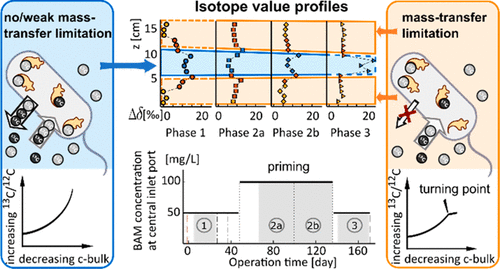F. Sun, A. Mellage, Z. Wang, R. Bakkour, Ch. Griebler, M. Thullner, O. Cirpka, M. Elsner
Environmental Science & Technology (2022)
Abstract
Compound-specific isotope analysis (CSIA) can reveal mass-transfer limitations during biodegradation of organic pollutants by enabling the detection of masked isotope fractionation. Here, we applied CSIA to monitor the adaptive response of bacterial degradation in inoculated sediment to low contaminant concentrations over time. We characterized Aminobacter sp. MSH1 activity in a flow-through sediment tank in response to a transient supply of elevated 2,6-dichlorobenzamide (BAM) concentrations as a priming strategy and took advantage of an inadvertent intermittence to investigate the effect of short-term flow fluctuations. Priming and flow fluctuations yielded improved biodegradation performance and increased biodegradation capacity, as evaluated from bacterial activity and residual concentration time series. However, changes in isotope ratios in space and over time evidenced that mass transfer became increasingly limiting for degradation of BAM at low concentrations under such stimulated conditions, and that activity decreased further due to bacterial adaptation at low BAM (μg/L) levels. Isotope ratios, in conjunction with residual substrate concentrations, therefore helped identifying underlying limitations of biodegradation in such a stimulated system, offering important insight for future optimization of remediation schemes.
